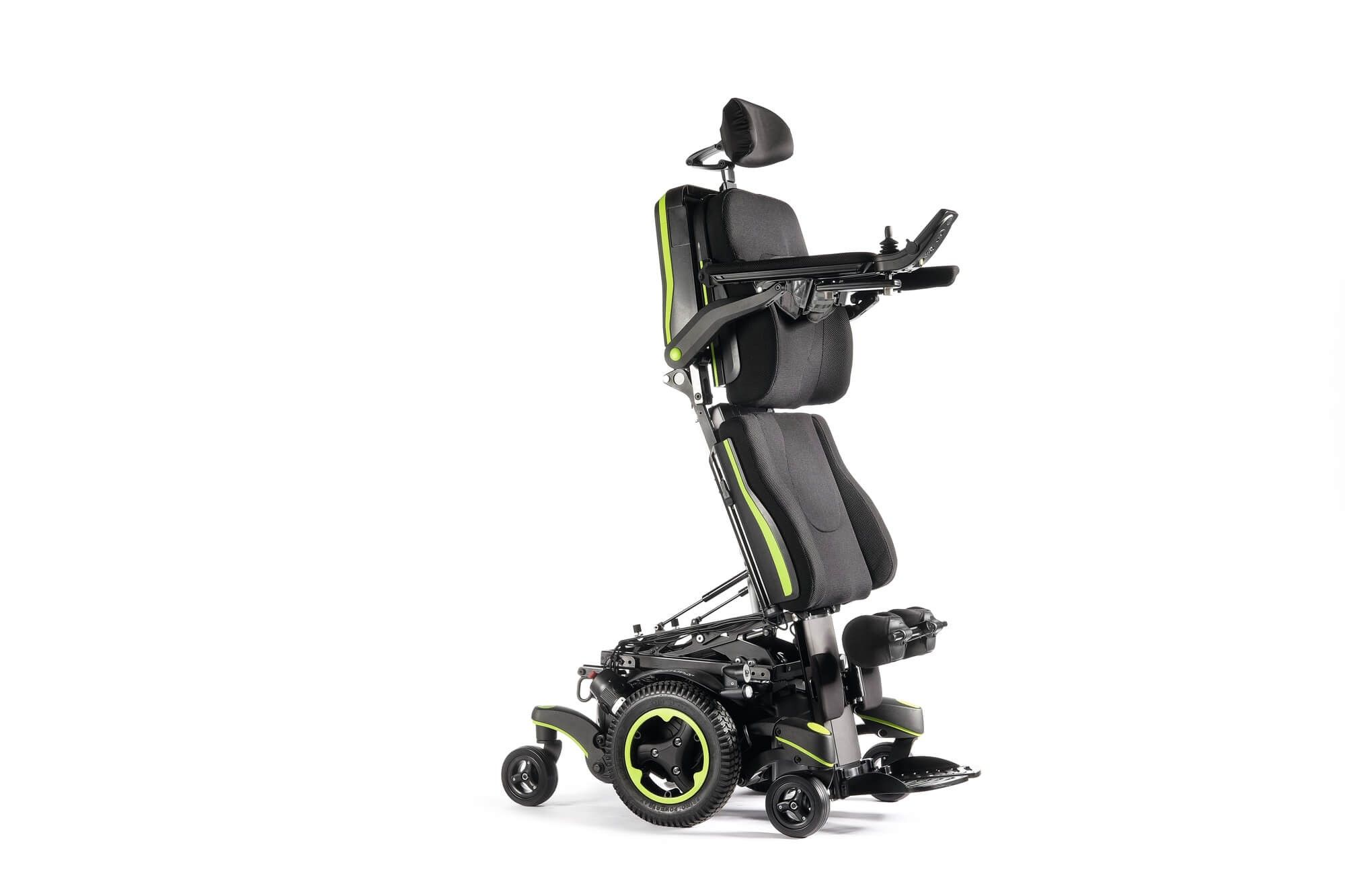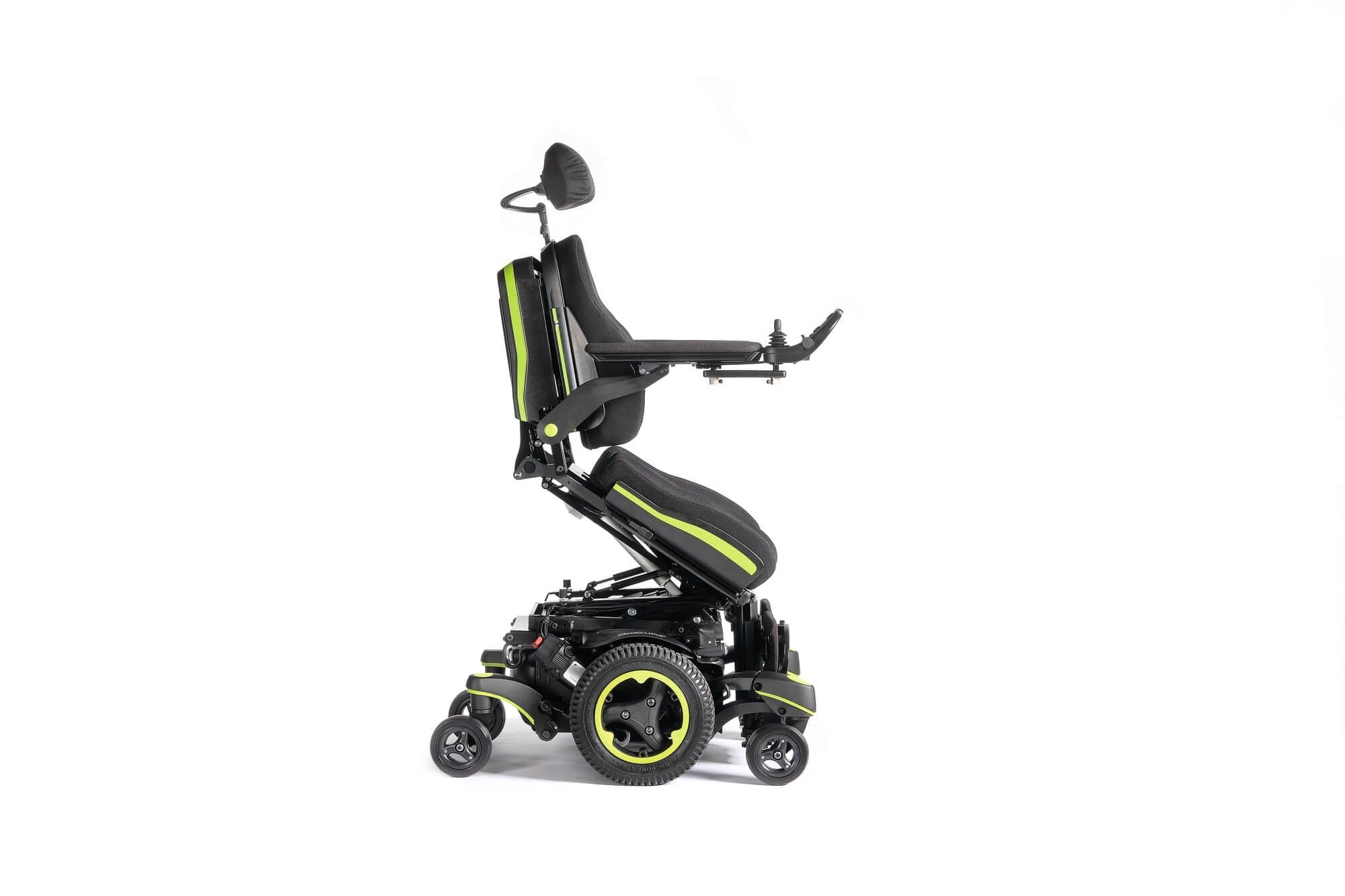Share:
Take it offline!
This Education in Motion resource is also available as a printable PDF.
Download PDF
Naturally, wheelchair users will spend a large proportion of their time in a seated position, unfortunately this can have a negative impact on their health with side effects including pressure ulcers. Standing powerchairs can offer a solution for wheelchair users who are looking to realise the health and lifestyle benefits of a more upright posture, or who want the ability to change position.
Physical Benefits of Standing Wheelchairs
Improved breathing function
When breathing, the human body needs to make use of the respiratory system, made up of respiratory organs and muscles. Wheelchair users tend to have respiratory compromise, whether that’s due to having restrictive function in the upper part of the body, or because being in a seated position means that the area is affected by pressure and gravity.
In a standing position, the spine is stabilised and pressure on the system is reduced, so that oxygen and blood circulates better. The respiratory function improves overall and breathing becomes less exhausting.
Blood flow enhancement
Blood circulation improves with standing for two reasons. The first is that the circulatory system keeps a strong connection with the respiratory system. This means that if standing helps the respiratory system to breathe better, the circulatory system will spread oxygen more effectively.
On the other hand, blood usually stagnates when spending a lot of time in a sitting position. That’s why, changing posture from sitting to standing and vice versa, will significantly improve circulation in lower limbs and reduce the risk of thrombosis.
Enhancing bladder & bowel function
Gravity plays an important role when it comes to getting rid of bodily waste. Standing makes it easier to empty the bladder and bowel.
As for the bladder, standing reduces the risk of infections due to incomplete urine draining, avoiding kidney and bladder stones at the same time.
In the case of the bowel, the effect of being able to extend the trunk will make the whole system function more efficiently and regularly.

Increased bone density
Holding up our own body weight is important to maintain bone health and strength. By keeping a sitting position, this option is absent, so the bones become fragile, increasing the risk of suffering osteoporosis (bone weakening) and bone deformities. Keeping a good bone density depends on multiple things like calcium, vitamin D and physical activity. When having no mobility in the lower limbs, weight bearing can be considered a kind of physical activity, so that standing will be advantageous in maintaining and/or increasing bone density.
On the other hand, standing repositions the posture, extending the trunk and postponing deformities and with less effort required for movement it reduces repetitive strain injuries in the bones and muscles of the upper body.
Pressure ulcers
Pressure ulcers are skin and tissue injuries, which happen because of constant pressure over the skin. In most cases, pressure ulcers appear over skin that covers the bones, including the coccyx, shoulder blades, backbone, etc. The most common way to prevent them is to use a cushion to provide the user with correct positioning and pressure relief. But certainly, having no pressure at all is even more effective as it is the only position where pressure is completely avoided and blood can freely circulate.
Reducing spasticity and contractures
Spasticity (also known as high muscular tone) is an imbalance of the central nervous system, which affects movement in different body areas. It is an exaggerated tension affecting muscles when no contractions are occurring (immobility) and causes rigidity. Additionally, spasticity induces muscle contractures.
Changing position will cause muscles in lower limbs to stretch and may help to loosen them, reducing spasms and spasticity-induced contractures. If the user has a powerchair without standing function, they will need someone to help them stretch their muscles, but with a standing powerchair, they can do it independently and more times throughout the day.
Other Benefits of Standing Wheelchairs
Independence
Independence is something usually compromised when lacking mobility. Standing wheelchairs are not able to bring all that independence back, but they could be a huge help to facilitate some new positions and activities that wouldn’t be possible if that standing option was absent. Apart from that, the cost of buying a powerchair with standing function may be compensated, as it lessens the need of home adaptations and reduces the levels of attendant care required, which can lead to a significant money saving. Independently reaching items on higher shelves is just one example of how standing wheelchair functionality can be beneficial.
Easier and safer transfers

High tone is sometimes a problem when it comes to transfers, as it becomes more difficult for the caregiver. As we have previously mentioned, standing could make the difference by reducing spasticity and contractures and to make transfers easier and safer. Some powerchairs (like the Q700-UP M by Sunrise Medical) also have a specific position to assist with transfers.

Social participation and engagement
Having a new height when standing can give powerchair users more confidence when it comes to engaging in social activities. They can interact whilst making eye contact with the people in their environment, making them feel more integrated into social situations and society.
Standing power chairs have many benefits, which are, together with the benefits of seat elevation, often perceived as a luxury. It is true that getting funds to buy these kinds of powerchairs can be difficult. In these cases it’s not just the clinical and social benefits of the wheelchair that need to be taken into consideration, but also the cost saving advantages of not requiring home adaptations and assistance.
To find out more about standing powered wheelchairs, including the Quickie Q700-UP M, visit your nearest authorised Quickie dealer and trial them for yourself.